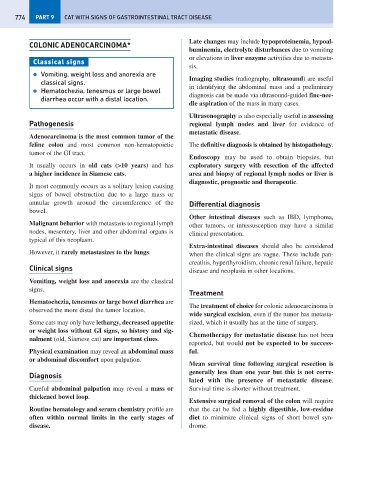Page 782 - Problem-Based Feline Medicine
P. 782
774 PART 9 CAT WITH SIGNS OF GASTROINTESTINAL TRACT DISEASE
Late changes may include hypoproteinemia, hypoal-
COLONIC ADENOCARCINOMA*
buminemia, electrolyte disturbances due to vomiting
or elevations in liver enzyme activities due to metasta-
Classical signs
sis.
● Vomiting, weight loss and anorexia are
Imaging studies (radiography, ultrasound) are useful
classical signs.
in identifying the abdominal mass and a preliminary
● Hematochezia, tenesmus or large bowel
diagnosis can be made via ultrasound-guided fine-nee-
diarrhea occur with a distal location.
dle aspiration of the mass in many cases.
Ultrasonography is also especially useful in assessing
Pathogenesis regional lymph nodes and liver for evidence of
metastatic disease.
Adenocarcinoma is the most common tumor of the
feline colon and most common non-hematopoietic The definitive diagnosis is obtained by histopathology.
tumor of the GI tract.
Endoscopy may be used to obtain biopsies, but
It usually occurs in old cats (>10 years) and has exploratory surgery with resection of the affected
a higher incidence in Siamese cats. area and biopsy of regional lymph nodes or liver is
diagnostic, prognostic and therapeutic.
It most commonly occurs as a solitary lesion causing
signs of bowel obstruction due to a large mass or
annular growth around the circumference of the Differential diagnosis
bowel.
Other intestinal diseases such as IBD, lymphoma,
Malignant behavior with metastasis to regional lymph other tumors, or intussusception may have a similar
nodes, mesentery, liver and other abdominal organs is clinical presentation.
typical of this neoplasm.
Extra-intestinal diseases should also be considered
However, it rarely metastasizes to the lungs. when the clinical signs are vague. These include pan-
creatitis, hyperthyroidism, chronic renal failure, hepatic
Clinical signs disease and neoplasia in other locations.
Vomiting, weight loss and anorexia are the classical
signs.
Treatment
Hematochezia, tenesmus or large bowel diarrhea are
The treatment of choice for colonic adenocarcinoma is
observed the more distal the tumor location.
wide surgical excision, even if the tumor has metasta-
Some cats may only have lethargy, decreased appetite sized, which it usually has at the time of surgery.
or weight loss without GI signs, so history and sig-
Chemotherapy for metastatic disease has not been
nalment (old, Siamese cat) are important clues.
reported, but would not be expected to be success-
Physical examination may reveal an abdominal mass ful.
or abdominal discomfort upon palpation.
Mean survival time following surgical resection is
generally less than one year but this is not corre-
Diagnosis
lated with the presence of metastatic disease.
Careful abdominal palpation may reveal a mass or Survival time is shorter without treatment.
thickened bowel loop.
Extensive surgical removal of the colon will require
Routine hematology and serum chemistry profile are that the cat be fed a highly digestible, low-residue
often within normal limits in the early stages of diet to minimize clinical signs of short bowel syn-
disease. drome.

